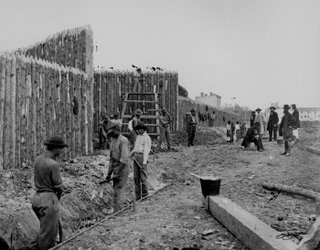The Joy Of Civilization: Master Drawings At The National Gallery Of Art, Washington, D.C., Through October 1, 2006

Sandro Botticelli
Florentine, 1446 - 1510
Head of a Youth Wearing a Cap; a Right Forearm with the Hand Clutching a Stone; and a Left Hand Holding a Drapery, 1480/1485
metalpoint heightened with white gouache on mauve-prepared paper, 28.7 x 20.1 cm (11 5/16 x 7 15/16 in.)
Woodner Collection, Patrons' Permanent Fund
1991.190.1.a
Master Drawings from the Woodner Collections
April 30–October 1, 2006
West Building, Central Gallery
Overview: Ian Woodner (1903–1990) formed one of the foremost private collections of old master and modern drawings in the United States. The core drawings of the collection were placed at the National Gallery of Art by Woodner's daughters in 1991, in honor of their father's achievement as a collector. This exhibition celebrates the 15th anniversary of the arrival of the Woodner drawings at the National Gallery and honors the ongoing generosity of Dian and Andrea Woodner, who have already donated many of the core drawings and have augmented the collection with additional gifts. Spanning more than five centuries of European draftsmanship, the show includes outstanding works by such great artists as Sandro Botticelli, Leonardo da Vinci, Albrecht Dürer, Raphael, Rembrandt van Rijn, Jean-Honoré Fragonard, Francisco de Goya, Jean-Auguste-Dominique Ingres, Edgar Degas, and Pablo Picasso.
Organization: Organized by the National Gallery of Art, Washington.
*
Amman, Jost
Head of a Bearded Man, 1572, brush and black ink with white wash on blue prepared paper, 1991.182.19
Barocci, Federico
Head of a Bearded Man, 1579/1582, red, black, white, and ochre chalks on blue laid paper; laid down, 1991.182.16
Botticelli, Sandro
Head of a Youth Wearing a Cap; a Right Forearm with the Hand Clutching a Stone; and a Left Hand Holding a Drapery, 1480/1485, metalpoint heightened with white gouache on mauve-prepared paper, 1991.190.1.a
Braque, Georges
Large Nude, 1927, brown chalk on wove paper laid down on canvas, 2000.25.1
Bresdin, Rodolphe
Fantasy Farmhouse, 1853, pen and black ink and gray wash with touches of red-brown crayon, surface scraping on Bristol board, 1991.182.22
Carpaccio, Vittore
Groups of Figures, c. 1513/1514, red chalk with pen and brown ink on laid paper, 1991.182.15.b
Martyrdom of the Ten Thousand, c. 1513, red chalk on laid paper, 1991.182.15.a
Cellini, Benvenuto
A Satyr, 1544/1545, pen and brown ink with brown wash over black chalk on laid paper; laid down, 1991.190.2
Cousin the Elder, Jean
Design for a Burgonet Helmet, c. 1545, pen and gray ink with gray wash over black chalk on laid paper, 1993.51.4
da Zevio, Altichiero, attributed to
Procession Entering a City, c. 1369, pen and brown ink and brown wash on laid paper mounted on original pale blue album sheet, 2000.25.2
Degas, Edgar
Self-Portrait, c. 1855, red chalk on laid paper, 1991.182.23
Spanish Dancers and Musicians, 1868/1869, watercolor and pen and black ink on wove paper, 2000.25.3
Delaune, Etienne
Design for the Backplate of a Suit of Parade Armor, 1555/1557, pen and black ink with gray wash and faint traces of black chalk along border line on laid paper, 1991.182.20
Dürer, Albrecht
Female Nude Praying, 1497/1500, pen and brown ink on laid paper, 1999.31.1
The Virgin Annunciate, 1495/1499, pen and brown ink on laid paper, 1993.51.1
Dutch(?) 18th Century
The Judgment of Paris, c. 1745, pen and black ink with gray wash on laid paper, 2001.3.1
Dyck, Anthony van, Sir
The Mystic Marriage of Saint Catherine, c. 1618, pen and brown ink with brown and gray washes over black chalk on laid paper, 1993.51.7
Goya, Francisco de
Mendigos que se llevan solos en Bordeaux (Beggars Who Get about on Their Own in Bordeaux), 1824/1827, black chalk on greenish laid paper, 1993.51.9
Holbein the Elder, Hans
Portrait of a Woman, c. 1508, silverpoint, brush and black and brown ink, and black chalk heightened with white on white prepared paper, 1991.182.18.a
Study of a Bearded Man, c. 1508/1510, silverpoint and black chalk heightened with white on white prepared paper, 1991.182.18.b
Ingres, Jean-Auguste-Dominique
Philippe Mengin de Bionval, 1812, graphite on wove paper, 1991.182.21
Two Studies of Virgil, c. 1812 and c. 1825, graphite on 5 joined sheets of paper, 1993.51.8
Lippi, Filippino
An Angel Carrying a Torch, c. 1500/1504, pen and brown ink and gray wash on laid paper, 1991.190.1.f
Dancing Putto Holding a Drapery, c. 1493/1497, pen and brown ink on laid paper, 1991.190.1.e
Man with a Stick, c. 1500, metalpoint heightened with white on gray-prepared paper, 1991.190.1.c
Standing Nude Youth, c. 1496, metalpoint heightened with white on gray-prepared paper, 1991.190.1.b
Standing Woman with Her Hands Clasped in Prayer, c. 1488, metalpoint heightened with white on gray-prepared paper, 1991.190.1.i
Two Angels Carrying Torches, c. 1501, pen and brown ink and brown wash on laid paper, pricked for transfer, 1991.190.1.g
Two Draped Women Standing on Either Side of a Herm, 1488/1493, metalpoint heightened with white on light green-prepared paper, 1991.190.1.j
Various Figure Studies, c. 1493/1495, metalpoint heightened with white on ochre-prepared paper with borders by Vasari in brown ink, 1991.190.1.d
Perugino, Pietro, Follower of
Archer Drawing a Bow, c. 1505, black chalk and brown wash, heightened with white and squared for transfer on laid paper, 1991.182.13
Picasso, Pablo
Head of a Woman, c. 1903, pastel on paper, 2001.3.2
Piranesi, Giovanni Battista
Fantasy of a Façade with Bizarre Ornaments, 1764/1766, pen and brown ink with brown wash over black chalk on laid paper, 1991.182.17
Raffaellino del Garbo
Saint Roch between Saints Anthony Abbot and Catherine of Alexandria, c. 1485/1495, gouache and brown wash heightened with white on laid paper, 1991.190.1.h
Raphael
Architectural Details and a Soldier, pen and brown ink on laid paper, 1993.51.3.b
Eight Apostles, c. 1514, red chalk over stylus underdrawing and traces of leadpoint on laid paper, cut in two pieces and rejoined; laid down, 1993.51.2
A Marble Horse on the Quirinal Hill, c. 1513, red chalk and pen and brown ink, with stylus underdrawing and traces of leadpoint on laid paper, 1993.51.3.a
Rembrandt van Rijn
Figures on the Anthoniesdijk Entering Houtewael, c. 1650, reed pen and brown ink on light brown washed laid paper, 1993.51.6.b
View of Houtewael near the Sint Anthoniespoort, c. 1650, reed pen and brown ink with gray-brown wash and touches of white on laid paper, 1993.51.6.a
Sarto, Andrea del
Head of Saint John the Baptist, c. 1523, black chalk on paper laid down on panel, 1991.182.14
Signorelli, Luca
Bust of a Youth Looking Upward, c. 1500, black chalk partially indented with a stylus on tan laid paper, 1991.8.1.a
Two Nude Figures, c. 1500, black chalk on tan laid paper, 1991.8.1.b
Signorelli, Luca, Workshop of
The Sacrifice of Isaac, c. 1500, red chalk with white heightening on laid paper, 2001.3.3
Swiss 16th Century
A Man in Armor, black chalk, pen and black ink, and gray wash heightened with white on red-orange prepared laid paper, 2000.25.4
Tiepolo, Giovanni Battista
Two Monks with a Prostrate Man, c. 1725, pen and brown ink with brown wash and added gray wash over black chalk on laid paper, laid down, 2001.3.4
Tiepolo, Giovanni Domenico
The Parting of Saints Peter and Paul, early 1790s, pen and brown ink with brown wash over charcoal on laid paper, 1993.51.5
Vasari, Giorgio with drawings by Filippino Lippi, Botticelli, and Raffaellino del Garbo
Page from "Libro de' Disegni", The sheets by Filippino Lippi and Botticelli were probably executed between 1480 and 1504; Vasari mounted the drawings and added the decorative framework after 1524., album page with ten drawings on recto and verso in various media with decoration in pen and brown ink, brown and gray wash, on light buff paper, 1991.190.1
To see which of these images are available for pre-viewing, and study, on-line, see:
http://www.nga.gov/cgi-bin/powner?Person=325150&Format=1
Source: http://www.nga.gov/cgi-bin/powner?Person=325150&Format=1

























